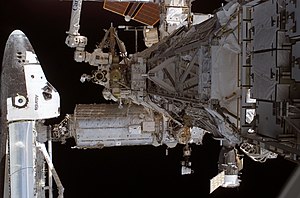As Open Source Spaceflight Hardware (OSSHW) developers, we love to see other people building, modifying, remixing, and using our designs. In fact, we believe that the “Prime Directive” of Open Hardware is that it must be reproducible. That’s why we got so excited when we were contacted through Open Design Engine by John and Christopher from Jones Boys’ Rocketry. Christopher was working on a rocketry project for school, and was attempting to get a copy of our Shepard Test Stand thrust measurement hardware working.

John and Christopher in February of ’08
Having someone build your Open Hardware has another advantage – you find more bugs and design flaws. The more people build and use your hardware, the better it gets. Our work with Jones Boys on Open Design Engine was no exception. They found a couple of bugs in our software, and their work brought about some operational improvements that we had glossed over because we’re so used to the hardware.

Christopher Testing the Shepard Hardware
After about two weeks of back-and-forth work, John and Christopher were able to get a successful data capture with a live engine.

Jones Boys’ Test Firing
Christopher was able to collect and analyze data from various motor fuel grain configurations and assembled everything into his science fair project display.

Christopher’s Display
Christopher took his display to multiple science fairs, and did extremely well. He was in 9th grade when he competed, and in the regional ISEF Science Fair, took first place in physics for his group. After that he went on to win second place in the American Institute of Aeronautics and Astronautics fair, which included a $100 cash award and a 3 day workshop at Goddard (I’m very envious). He also got an honorable mention from the USAF Office of Scientific Research.

Christopher Explaining His Project at the Science Fair
Congratulations to Christopher for doing a great job, and thanks to him for using Mach 30 hardware. We’re always excited to work with people who want to build spaceflight related hardware without starting from scratch. If you’re interested in building a rocket motor test stand or satellite receiving ground station, please feel free to contact us. We’d love to talk with you.
ad astra per civitatem – to the stars through community






